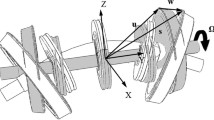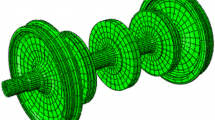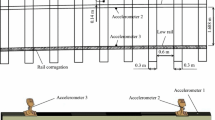Abstract
A frequency and amplitude dependent model is used to describe the complex behavior of rail pads. It is implemented into the dynamic analysis of three dimensional coupled vehicle-slab track (3D-CVST) systems. The vehicle is treated as a 35-degree-of-freedom multi-body system, and the slab track is represented by two continuous Bernoulli-Euler beams supported by a series of elastic rectangle plates on a viscoelastic foundation. The rail pad model takes into account the influences of the excitation frequency and of the displacement amplitude through a fractional derivative element, and a nonlinear friction element, respectively. The Grünwald representation of the fractional derivatives is employed to numerically solve the fractional and nonlinear equations of motion of the 3D-CVST system by means of an explicit integration algorithm. A dynamic analysis of the 3D-CVST system exposed to excitations of rail harmonic irregularities is primarily carried out, which reveals the dependence of stiffness and damping on excitation frequency and displacement amplitude. Subsequently, sensitive analyses of the model parameters are investigated by conducting the dynamic analysis of the 3D-CVST system subjected to excitations of welded rail joint irregularities. Following this, parameters of the rail pad model are optimized with respect to experimental values. For elucidation, the 3D-CVST dynamic model incorporated with the rail pads model is used to calculate the wheel/rail forces induced by excitations of measured random track irregularities. Further, the numerical results are compared with experimental data, demonstrating the reliability of the proposed model.
Similar content being viewed by others
References
Grassie S L. Resilient railpads: Their dynamic behaviour in the laboratory and on track. P I Mech Eng F-J Rai, 1989, 203: 25–32
Bezin Y, Farrington D, Penny C, et al. The dynamic response of slab track constructions and their benefit with respect to conventional ballasted track. Veh Syst Dyn, 2010, 48: 175–193
Blanco-Lorenzo J, Santamaria J, Vadillo E G, et al. Dynamic comparison of different types of slab track and ballasted track using a flexible track model. P I Mech Eng F-J Rai, 2011, 225: 574–592
Hussein M F M, Hunt H E M. Modelling of floating-slab tracks with continuous slabs under oscillating moving loads. J Sound Vib, 2006, 297: 37–54
Kuo C, Huang C, Chen Y. Vibration characteristics of floating slab track. J Sound Vib, 2008, 317: 1017–1034
Lombaert G, Degrande G, Vanhauwere B, et al. The control of ground-borne vibrations from railway traffic by means of continuous floating slabs. J Sound Vib, 2006, 297: 946–961
Sun Y Q, Dhanasekar M. A dynamic model for the vertical interaction of the rail track and wagon system. Int J Solids Struct, 2002, 39: 1337–1359
Vostroukhov A V, Metrikine A V. Periodically supported beam on a visco-elastic layer as a model for dynamic analysis of a high-speed railway track. Int J Solids Struct, 2003, 40: 5723–5752
Zhu S Y, Fu Q, Cai, C B, et al. Damage evolution and dynamic response of cement asphalt mortar layer of slab track under vehicle dynamic load. Sci China Tech Sci, 2014, 57: 1883–1894
Zhai W, Wang K, Cai C. Fundamentals of vehicle-track coupled dynamics. Veh Syst Dyn, 2009, 47: 1349–1376
Zhu S, Cai C. Interface damage and its effect on vibrations of slab track under temperature and vehicle dynamic loads. Int J Nonlinear Mech, 2014, 58: 222–232
Fenander Å. Frequency dependent stiffness and damping of railpads. P I Mech Eng F-J Rai, 1997, 211: 51–62
Bruni S, Collina A. Modelling the viscoelastic behaviour of elastomeric components: An application to the simulation of train-track interaction. Veh Syst Dyn, 2000, 34: 283–301
Alonso A, Gil-Negrete N, Nieto J, et al. Development of a rubber component model suitable for being implemented in railway dynamic simulation programs. J Sound Vib, 2013, 332: 3032–3048
Gil-Negrete N, Vinolas J, Kari L. A nonlinear rubber material model combining fractional order viscoelasticity and amplitude dependent effects. J Appl Mech, 2009, 76: 1–9
Sjöberg M M, Kari L. Non-linear behavior of a rubber isolator system using fractional derivatives. Veh Syst Dyn, 2002, 37: 217–236
Eldred L B, Baker W P, Palazotto A N. Numerical application of fractional derivative model constitutive relations for viscoelastic materials. Comput Struct, 1996, 60: 875–882
Rossikhin Y A, Shitikova M V. Applications of fractional calculus to dynamic problems of linear and nonlinear hereditary mechanics of solids. Appl Mech Rev, 1997, 50: 15–67
Enelund M, Olsson P. Damping described by fading memory-analysis and applications to fractional derivative models. Int J Solids Struct, 1999, 36: 939–970
Berg M. A model for rubber springs in the dynamic analysis of rail vehicles. P I Mech Eng F-J Rai, 1997, 211: 95–108
Blom P, Kari L. A nonlinear constitutive audio frequency magneto-sensitive rubber model including amplitude, frequency and magnetic field dependence. J Sound Vib, 2011, 330: 947–954
Sjöberg M. Nonlinear isolator dynamics at finite deformations: An effective hyperelastic, fractional derivative, generalized friction model. Nonlinear Dyn, 2003, 33: 323–336
Podlubny I. Fractional Differential Equations. San Diego: Academic Press,1999: 41–117
Spanos P D, Evangelatos G I. Response of a non-linear system with restoring forces governed by fractional derivatives-time domain simulation and statistical linearization solution. Soil Dyn Earthq Eng, 2010, 30: 811–821
Zhai W. Vehicle-Track Coupled Dynamics (in Chinese). Beijing: Science Press, 2007. 71–85
Zhai W, Xia H, Cai C, et al. High-speed train-track-bridge dynamic interactions-Part I: Theoretical model and numerical simulation. Int J Rail Transport, 2013, 1: 3–24
Falomi S, Meli E, Malvezzi M, et al. Determination of wheel-rail contact points: Comparison between classical and neural network based procedures. Meccanica, 2009, 44: 661–686
Ignesti M, Innocenti A, Marini L, et al. Wheel profile optimization on railway vehicles from the wear viewpoint. Int J Nonlinear Mech, 2013, 53: 41–54
Meli E, Falomi S, Malvezzi M, et al. Determination of wheel-rail contact points with semianalytic methods. Multibody Syst Dyn, 2008, 20: 327–358
Pombo J, Ambrosio J. Application of a wheel-rail contact model to railway dynamics in small radius curved tracks. Multibody Syst Dyn, 2008, 19: 91–114
Shabana A A, Zaazaa K E, Escalona J L, et al. Development of elastic force model for wheel/rail contact problems. J Sound Vib, 2004, 269: 295–325
Chen G, Zhai W M. A new wheel/rail spatially dynamic coupling model and its verification. Veh Syst Dyn, 2004, 41: 301–322
Shen Z, Hedrick J, Elkins J. A comparison of alternative creep-force models for rail vehicle dynamic analysis. In: Proceedings of the 8th IAVSD symposium, 1984. 591–605
Zhai W M. Two simple fast integration methods for large-scale dynamic problems in engineering. Int J Numer Methods Eng, 1996, 39: 4199–4214
Jin X S, Wen Z F. Effect of discrete track support by sleepers on rail corrugation at a curved track. J Sound Vib, 2008, 315: 279–300
Zhu S, Cai C. Stress intensity factors evaluation for through-transverse crack in slab track system under vehicle dynamic load. Eng Fail Anal, 2014, 46: 219–237
Zhai W, Wang K. Lateral hunting stability of railway vehicles running on elastic track structures. J Comput Nonlinear Dynam, 2010, 5: 520–530
Zhai W, Wang S, Zhang N, et al. High-speed train-track-bridge dynamic interactions-Part II: Experimental validation and engineering application. Int J Rail Transport, 2013, 1: 25–41
Author information
Authors and Affiliations
Corresponding author
Rights and permissions
About this article
Cite this article
Zhu, S., Cai, C., Luo, Z. et al. A frequency and amplitude dependent model of rail pads for the dynamic analysis of train-track interaction. Sci. China Technol. Sci. 58, 191–201 (2015). https://doi.org/10.1007/s11431-014-5686-y
Received:
Accepted:
Published:
Issue Date:
DOI: https://doi.org/10.1007/s11431-014-5686-y




